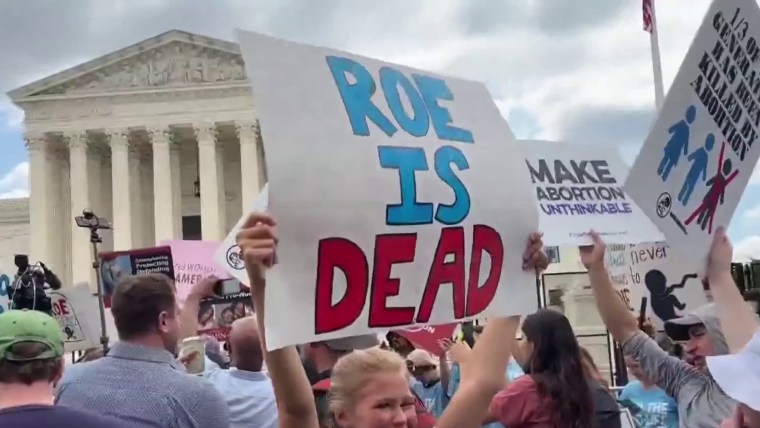
The Supreme Court decision overturning Roe v. Wade — which happened a year ago Saturday — immediately tore down almost 50 years of federal abortion rights.
Just as quickly, it created a deluge of legal and political consequences by giving state governments and courts the power to decide how reproductive care should be regulated for residents in their jurisdictions.
The result has been a tapestry of laws that differ, often dramatically. That, in turn, has prompted a wave of lawsuits, rulings, ballot measures and proposed constitutional amendments all seeking to regulate abortion care.
And the subsequent effect of it all on national politics has been monumental.
Here are five of the most consequential state government trends that emerged across the United States in the year since the Dobbs v. Jackson Women’s Health Organization decision.
Bans, bans, bans
A variety of abortion bans went into quick effect in the days — and sometimes seconds — after Roe was overturned.
In at least 13 states, so-called trigger bans snapped into place immediately or soon after the 2022 ruling, though some have remained temporarily blocked in court. In nine, bans that predated the 1973 Supreme Court ruling guaranteeing a constitutional right to abortion went into effect immediately. (And in some, both went into effect.)
One such ban that predated Roe is a Wisconsin law — enacted in 1849 (months after Wisconsin was admitted into the union) — banning abortions in almost all cases.
Other states, in the months since the Dobbs decision, have enacted new strict abortion bans. Florida, for example, banned abortion at six weeks of pregnancy, before most women even know they’re pregnant, though it remains temporarily blocked by a judge.
In total (when accounting for states where such bans remain blocked for the time being), more than a dozen have banned abortion care almost completely or no longer have facilities where women can receive abortions, as of June 16, according to an NBC News review of state laws.
Huge momentum for Democrats
Almost immediately, Democrats seized on the Dobbs ruling as a way to mobilize, woo and turn out voters — particularly independents, as well as women and suburban swing voters — who support abortion rights.
It was a prominent focus for Democrats in Senate, House and gubernatorial races in swing states across the country last fall. Many politics watchers said the strategy was, in large part, the reason the party kept the Senate, overperformed in House races and won every swing state governorship, except one.
In many states, the issue forced anti-abortion Republican candidates to defend the strict abortion bans following the Dobbs decision — and the issue remains a conundrum for the GOP.
Earlier this year, liberals won a state Supreme Court race in Wisconsin by 11 percentage points, largely because of their candidate’s emphasis on her desire to overturn the state’s 1849 law and her conservative challenger’s unwillingness to engage on the issue of abortion at all.
Ballot initiatives boosting abortion protections
Similarly, abortion rights advocates also waged their political battles by putting referendums on ballots last year that would enshrine reproductive rights in state constitutions.
Those advocates enjoyed a clean sweep of victories, winning in all six states that held them — even in conservative states such as Kentucky and Kansas.
Subsequently, reproductive rights groups — energized by that perfect record last year — set their sights on planning citizen-led ballot initiatives that would enshrine abortion rights in the constitutions of 10 states this year and the next.
While some efforts have stalled, many haven’t. For example, in Ohio, an effort called Protect Choice Ohio has so far cleared all hurdles in placing a citizen-initiated constitutional amendment on the ballot in November that would enshrine abortion rights in the state constitution.
The proposed amendment is designed to counteract Ohio’s “heartbeat bill,” which snapped back into place immediately after Roe was overturned last summer. That law, which effectively bans most abortions, remains temporarily blocked by a state judge.
Ballot initiatives that would limit abortion protections
Those endeavors, however, have given way to counterefforts designed to make it harder for reproductive rights advocates to amend state constitutions.
Republican-led legislatures have in many of the same states mounted fierce battles to curb the ability of citizens and other lawmakers to place ballot measures — a move progressive groups say is explicitly aimed at making it difficult to give voters in red and purple states direct say over major issues such as abortion rights.
In Ohio, the GOP-controlled Legislature passed a series of measures last month that could make it harder to amend the state constitution to protect abortion rights. Ohio voters will now head to the polls Aug. 8 to decide whether to raise to 60% the threshold of support required for passage of ballot measures that amend the state constitution. Currently, just a majority is needed.
Reproductive rights groups contend the move is designed to make it more difficult for voters to pass the proposed pro-abortion amendment set to be on the ballot in November.
A focus on interstate care
Lawmakers in some blue states have said they’ve enacted abortion protections in recent months not only for the benefit of their own residents, but also for residents of other states, particularly those in neighboring conservative ones where newly implemented bans have taken effect.
This year, for example, Democrats in the Minnesota Legislature moved to enshrine abortion rights into law — a measure that abortion-rights advocates have touted as especially crucial for pregnant women in neighboring states (such as Wisconsin, South Dakota and North Dakota) where abortion became illegal after the the Dobbs decision.
For months, North Carolina had remained a haven for women seeking care; it was only one of two states in the broader South where they could get a legal abortion until the 20th week of pregnancy. But a 12-week ban will go into effect July 1, after the state’s GOP-controlled Legislature recently overrode a veto of the measure by Democratic Gov. Roy Cooper. The enactment of the 12-week ban could, for many women across the region who can afford to only go so far, make it impossible to travel to receive abortion care.
As a result, Virginia will soon be the only remaining state in the region that has not narrowed access to abortion care in the past year.
The issue of interstate travel for abortion care became increasingly important after a man was arrested last year on charges of raping a 10-year-old girl, who became pregnant and was reported to have traveled from Ohio to Indiana to get an abortion.
Nevertheless, some states are cracking down on any possibility of such travel.
Idaho, in April, became the first state to pass a law explicitly restricting some of its residents from traveling out of state for any such care at all. The new legislation made helping a pregnant minor get an abortion, whether through medication or a procedure, in another state punishable by years in prison. In addition, laws in Oklahoma and Texas allow lawsuits against people, anywhere in the U.S., who help facilitate an abortion within those states’ borders.
Meanwhile, other states — in response to the possibility of punishment from authorities in conservative states with abortion bans — have enacted measures designed to protect doctors within their own borders who provide care to out-of-state residents.
That includes a law signed last month by Nevada Gov. Joe Lombardo — one of a small handful of Republican governors to move to codify any abortion rights at all in recent years — that protects abortion rights for out-of-state patients seeking care in the state, as well as for providers within the state.

 Latest Breaking News Online News Portal
Latest Breaking News Online News Portal





